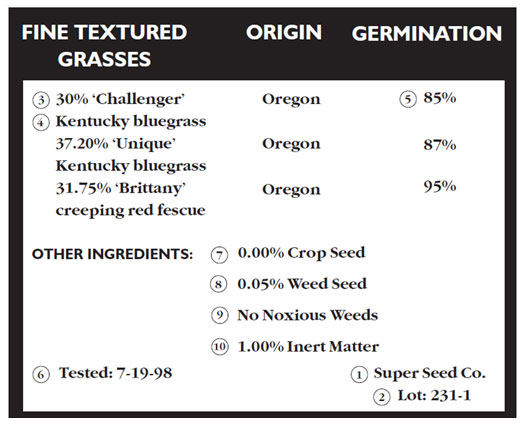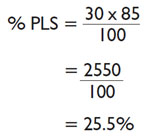Understanding a Turfgrass Seed Label
Seeding Objectives
The objective of any seeding is to establish a mature, permanent and high quality turfgrass stand in the shortest period of time possible. To that end, the process may begin with soil modification, including grading to insure proper surface water drainage, application of topsoil, and incorporation of appropriate amendments (based on soil test results) such as fertilizers and lime. Selection of recommended turfgrass species, cultivars, and mixtures or blends as well as proper post-planting care and cultural practices will encourage rapid establishment of a successful seeding. This fact sheet discusses factors pertaining to understanding seed label information and other seed quality issues.

Seed Selection (Recommended Mixtures)
The seed mixtures shown in Table 1 are “recipes” to be followed for central New England, for general turf areas fertilized and mowed on a regular basis. These turf areas include athletic fields, home lawn turf, commercial properties, and parks and recreational areas. It is strongly recommended that each species component of a mixture contain cultivars (varieties) which have been shown to perform well in Massachusetts. At least 2 to 3 cultivars from each species of Kentucky bluegrass or perennial ryegrass should be “blended” together in formulating a mixture, and 1 or more cultivars of tall or fine leaf fescue may be blended in formulating a mixture as recommended in Table 1. Finally, certified seed is strongly recommended because certification is the only insurance that cultivar authenticity can be guaranteed.
| Use | Species (% by weight) | rate (lbs/1000ft2) |
|---|---|---|
| Athletic Fields |
80% Kentucky bluegrass* 20% perennial ryegrass* (new fields) |
3 to 4 |
|
100% perennial ryegrass* (overseeding key wear areas) |
6 to 8** | |
| Lawns - sun (med to high maint) |
65 to 75% Kentucky bluegrass* 10 to 20% perennial ryegrass* 15% fine fescue*** |
3 to 4 |
| Lawns - sun (low maint) |
65% fine fescue* 10 to 20% perennial ryegrass* remainder Kentucky Bluegrass |
4 to 6 |
| Lawns - shade (well drained) |
80 to 90% fine fescue* 10 to 20% perennial ryegrass* |
4 to 6 |
|
80% shade tolerant K. bluegrass* 20% perennial ryegrass* |
3 to 4 | |
| Lawns - shade (wet) |
70% 'Sabre' rough bluegrass 30% shade tolerant K. bluegrass* |
2 to 3 |
|
* Two to three improved cultivars recommended ** Recommended rate when more than 50% of the area is bare soil ***One or more improved cultivars recommended |
||
Understanding Seed Labels and Seed Quality Issues
The single most important investment in ensuring high quality turf is the purchase of high quality seed. Anyone purchasing seed must be aware of seed label terminology and its meaning in order to understand and interpret seed tag analysis information. For example, purchasing outdated seed that is not capable of growth, or seed containing high weed seed content can increase the chances of seeding failure and poor results. The seed analysis tag tells the exactly what is contained inside the seed package.
By federal law, the following information must be listed on the seed analysis tag:
- The name of the seller: On the sample seed label, Super Seed Co. is the seller.
- Lot number: Maintain a record of all seed analysis tags because they contain the name of the seller (supplier) and lot number. The supplier’s name is useful if the same seed is to be reordered. The lot number is also useful to have. Should a problem develop, the supplier will be able to more accurately track vital seed information pertaining to the origin of the seed using the lot identification number listed on the seed analysis label.
- The seed variety or varieties: ‘Challenger’ and ‘Unique’ are the two varieties of Kentucky bluegrass and ‘Brittany’ is the variety of creeping red fescue in the sample given. Scientific names of grasses may be listed, but are not required.
- Purity: Purity is the percent by weight of each seed component (variety or species) in a mixture as expressed on the seed analysis tag or label. Purity is not necessarily an indication of “seed quality” but rather is a measure of “seed quantity.” The sample listed is 30% pure ‘Challenger’ Kentucky bluegrass, 37.20% pure ‘Unique’ Kentucky bluegrass and 31.75% pure ‘Brittany’ creeping red fescue. As another example, a seed tag which lists Kentucky bluegrass as 95% pure, indicates for each 100 lb. of seed, 95 lb. is pure Kentucky bluegrass seed. However, it is important to recognize that not all pure seed is capable of growth and surviving to maturity.
- Germination Percentage,
- Date: Germination is expressed on the seed label as the percentage of pure seed that is capable of growth. This value is determined according to strict laboratory procedures that are near “ideal conditions” in terms of temperature and moisture for germination compared to typical field conditions. Therefore, germination percentages indicated on the seed analysis tag do not necessarily reflect the percentage of seed that would be expected to survive the less than ideal conditions in the field. Germination declines with age of the seed and therefore seed older than 9 months to 1 year may be less viable than fresh seed. The date of when the seed was tested for germination is included on the analysis tag as an indication of freshness and to protect the buyer. Only the freshest seed of the highest purity and germination should be purchased. The “minimum” purity and germination is guaranteed by law and varies with the species. The minimum purity and germination percentages by species are shown in Table 2.
Both purity and germination are important components of seed quality and are used to compute a term called Pure Live Seed (PLS) defined as:
Using the sample label, to calculate the amount of Pure Live Seed of ‘Challenger’ Kentucky bluegrass with purity of 30% and germination rate of 85%:
This means that a 100 lb. bag of the sample mix contains 30 lb. of pure ‘Challenger’ Kentucky bluegrass, but that only 25.5 lbs. are pure LIVE seed capable of germinating as of the date listed on the seed tag. - Crop seed content: Crop seed content is the percent by weight of all seeds identified in the container which are grown as an “agricultural crop.” These must be specified by name if in excess of 5% by weight. Crop seed content can be more undesirable than some weed seeds as a source of contamination. Both bentgrass and tall fescue are grown as agricultural crops and are extremely undesirable in Kentucky bluegrass sod. For example, if 1% by weight of the seed in a container is bentgrass, this would equate to approximately 90,000 bentgrass seeds per pound of actual seed. Therefore, crop seed content should be as low as possible!
- Weed seed: The percent by weight of all seeds in the container which have not been identified as either pure seed or crop seed. This value should be as low as possible, ideally should be 0.5% or less.
- Noxious weeds: Expressed on the label as the number per pound or per ounce found in the seed lot. Those weeds classified as noxious can vary by state and are considered undesirable because these weeds are difficult to manage even with proper chemical and cultural practices. For example, Poa annua (annual bluegrass) is considered a noxious weed in some states and none is permitted in seed certified as Sod Quality.
- Inert matter: The percent by weight of all material in the seed container that will not grow. Includes seed parts (broken seed, chaff), soil, and other inert material left over from cleaning operations. This value should be as low as possible since seed cost is based on bag weight and inert material contributes to bag weight but does not contribute any value in term of seed quality or purity.
Certified Seed
Certified seed carries a color-coded blue certification tag fixed to the seed container with the name of the cultivar or variety. The certification tag is insurance for the professional consumer that the variety in the container is certified to be as stated. Certification only guarantees the authenticity of the cultivar and implies no guarantee as to the quality (purity, germination, crop and weed seed content) of the seed. Seed quality information is listed on the seed analysis tag while varietal guarantees of the seed are listed by name on the certification tag. The standards for certification are more rigid than the minimum guarantees for purity and germination required by law as shown in Table 2. For example, Kentucky bluegrass minimum guaranteed purity is 90% (Table 2) while the minimum purity for Blue tag certification is 95% and for Gold tag (Sod Quality) is 96 to 97%. The standards for weed and crop seed content are also more rigid for certification.
| Species | Growth Habit | seeds per/lb | seeding rate lb/1000ft2 | minimum purity % | Minimum gemination % | Pure live seed % |
|---|---|---|---|---|---|---|
| Bentgrass | ||||||
| colonial | stolons | 8,723,000 | 0.5 to 1.0 | 95 | 85 | 80.75 |
| creeping | stolons | 7,890,000 | 0.5 to 1.0 | 95 | 85 | 80.75 |
| Bluegrass | ||||||
| kentucky | rhizomes | 2,177,000 | 1.0 to 2.0 | 90 | 75 |
67.5 |
| rough | stolons | 2, 540,000 | 1.0 to 2.0 | 90 | 80 | 72.0 |
| Fescue | ||||||
| red | various | 546,000 | 4.0 to 6.0 | 95 | 80 | 76.0 |
| tall | bunch | 227,000 | 7.0 to 9.0 | 95 | 85 | 80.75 |
| Ryegrass | ||||||
| annual | bunch | 227,000 | 7.0 to 9.0 | 95 | 90 | 85.5 |
| perennial | bunch | 227,000 | 7.0 to 9.0 | 95 | 90 | 85.5 |
Revised: 05/2011